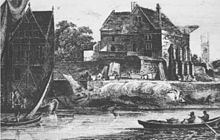 | ||
Similar HM Prison Gloucester, St Briavels Castle, Beverston Castle, Llanthony Secunda, Monmouth County Gaol | ||
Gloucester Castle was a castle in the city of Gloucester in the county of Gloucestershire. The castle was demolished and Gloucester Prison built on the site.
Contents
Early Norman motte and bailey castle
Probably constructed by Roger de Pitres, who was also the first Norman Sheriff of Gloucester. It began as a simple motte and bailey castle during the reign of William the Conqueror when sixteen houses were demolished to make way for it. It was enlarged by William Rufus who demolished eight more houses. It was placed in the custody of the sheriff of the county, Walter of Gloucester.
Improvements
Before 1112 Walter built a new castle west of Barbican hill on a former garden of Gloucester Abbey, overlooking the River Severn. The hereditary sheriffs of Gloucester held Gloucester castle until 1155 and later it was retained by the Crown.
King's residence
It was further extended by Henry I and Henry II. More improvements and some repairs were carried out by Henry III, these improvements including a bridge across the River Severn leading to a barbican in the outer wall. Henry III often used it as a residence, and it played an important role in the barons' war when it was besieged twice in 1264-5. Part of the castle had been being used as a gaol by 1185 and it was probably then the official county gaol, as it certainly was by 1228, and Eleanor of Brittany, niece of King John and cousin of Henry III with a better claim to the throne according to primogeniture and thus becoming a state prisoner, had been briefly imprisoned there during the reign of John, from 1222 to 1223, and from 1237 to 1238, and for the second time its prisoners had to be transferred to accommodate her.
More work was done on the castle during the reigns of Edward I, Edward II and Edward III.
Decline
The defences were kept in full repair until the mid 15th century. It is likely that in the reign of Richard III the castle ceased to be maintained as a fortress, continuing in use only as the county gaol. Much of the stonework of the castle was taken to construct roads and other buildings and by the mid 17th century all the buildings around the curtain wall had apparently gone, leaving only the keep, used as the gaol, and the main gatehouse standing.
Gaol
In time the keep was considered to be unsuitable for use as a gaol and its demolition began in 1787. The new gaol was finished in 1791 leaving no visible remains of the castle.
Modern times
The Castle was rediscovered in December 2015 by Archaeologists who are investigating the Gloucester Prison site ahead of a new development. Since being rediscovered there have been calls to make the site open to the public. The owners of the site, are currently considering how they will include parts of the castle in their plans for the site's future.
